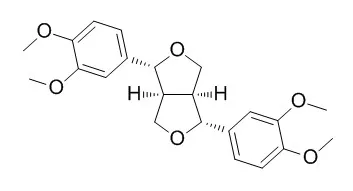| Description: |
Eudesmin shows antiinflammatory, neuritogenic, anticonvulsant and sedative effects, the mechanism of eudesmin may be related to up-regulation of GABAA and GAD65 expressions, and anti-apoptosis of neuron the in brain.50 microM (+)-eudesmin can induce neurite outgrowth and enhance nerve growth factor (NGF)-mediated neurite outgrowth from PC12 cells by stimulating up-stream MAPK, PKC and PKA pathways. |
| Targets: |
TNF-α | MAPK | PKC | PKA | GABA Receptor | NGF |
| In vitro: |
| Arch Pharm Res. 1999 Aug;22(4):348-53. | | Eudesmin inhibits tumor necrosis factor-alpha production and T cell proliferation.[Pubmed: 10489872] | Possible antiinflammatory effects of Eudesmin were examined by assessing the effects on tumor necrosis factor (TNF)-alpha production and lymphocyte proliferation as well as cytotoxicity against murine and human macrophages.
METHODS AND RESULTS:
The compound significantly inhibited TNF-alpha production by lipopolysaccharide (LPS)-stimulated murine macrophage RAW264.7 without displaying cytotoxicity suggesting that Eudesmin may inhibit TNF-alpha production without any interference of normal cell function. It also significantly attenuated T cell proliferation stimulated by concanavalin A (Con A) in a dose-dependent manner. | | Arch Pharm Res. 2006 Dec;29(12):1114-8. | | Effects of (+)-eudesmin from the stem bark of magnolia kobus DC. var. borealis Sarg. on neurite outgrowth in PC12 cells.[Pubmed: 17225460] |
METHODS AND RESULTS:
(+)-Eudesmin [4,8-bis(3,4-dimethoxyphenyl)-3,7-dioxabicyclo[3.3.0]octane] was isolated from the stem bark of Magnolia kobus DC. var. borealis Sarg. and found to have neuritogenic activity. 50 microM (+)-Eudesmin induced neurite outgrowth and enhanced nerve growth factor (NGF)-mediated neurite outgrowth from PC12 cells. At this concentration, (+)-Eudesmin also enhanced NGF-induced neurite-bearing activity and this activity was partially blocked by various protein kinase inhibitors. These included PD98059, a mitogen-activated protein kinase (MAPK) kinase inhibitor. GF109203X, a protein kinase C (PKC) inhibitor and H89, a protein kinase A (PKA) inhibitor.
CONCLUSIONS:
These results suggest that (+)-Eudesmin can induce neurite outgrowth from PC12 cells by stimulating up-stream MAPK, PKC and PKA pathways. |
|
| In vivo: |
| Phytother Res. 2015 Jul;29(7):996-1003 | | Anticonvulsant and Sedative Effects of Eudesmin isolated from Acorus tatarinowii on mice and rats.[Pubmed: 25851178 ] | This paper was designed to investigate anticonvulsant and sedative effects of Eudesmin isolated from Acorus tatarinowii.
METHODS AND RESULTS:
The Eudesmin (5, 10, and 20 mg/kg) was administered intraperitoneally (i.p.). The maximal electroshock test (MES) and pentylenetertrazole (PTZ)-induced seizures in male mice were used to evaluate anticonvulsant activities of Eudesmin, and sedative effects of Eudesmin were evaluated by pentobarbital sodium-induced sleeping time (PST) and locomotor activity in mice. Finally, the mechanisms of Eudesmin were investigated by determining contents of glutamic acid (Glu) and gamma-aminobutyric acid (GABA) in epileptic mice, and expressions of glutamate decarboxylase 65 (GAD65), GABAA , Bcl-2, and caspase-3 in the brain of chronic epileptic rats. Results of MES and PTZ tests revealed that Eudesmin possesses significant anticonvulsant effects, and the PST and locomotor activity tests demonstrated that Eudesmin has significant sedative effects. Furthermore, our study revealed that after treatment with Eudesmin, GABA contents increased, whereas Glu contents decreased, and ratio of Glu/GABA decreased. Our results also indicated that expressions of GAD65, GABAA, and Bcl-2 were up-regulated by treating with Eudesmin, whereas the caspase-3 obviously was down-regulated.
CONCLUSIONS:
In conclusion, Eudesmin has significant anticonvulsant and sedative effects, and the mechanism of Eudesmin may be related to up-regulation of GABAA and GAD65 expressions, and anti-apoptosis of neuron the in brain. |
|






 Cell. 2018 Jan 11;172(1-2):249-261.e12. doi: 10.1016/j.cell.2017.12.019.IF=36.216(2019)
Cell. 2018 Jan 11;172(1-2):249-261.e12. doi: 10.1016/j.cell.2017.12.019.IF=36.216(2019) Cell Metab. 2020 Mar 3;31(3):534-548.e5. doi: 10.1016/j.cmet.2020.01.002.IF=22.415(2019)
Cell Metab. 2020 Mar 3;31(3):534-548.e5. doi: 10.1016/j.cmet.2020.01.002.IF=22.415(2019) Mol Cell. 2017 Nov 16;68(4):673-685.e6. doi: 10.1016/j.molcel.2017.10.022.IF=14.548(2019)
Mol Cell. 2017 Nov 16;68(4):673-685.e6. doi: 10.1016/j.molcel.2017.10.022.IF=14.548(2019)